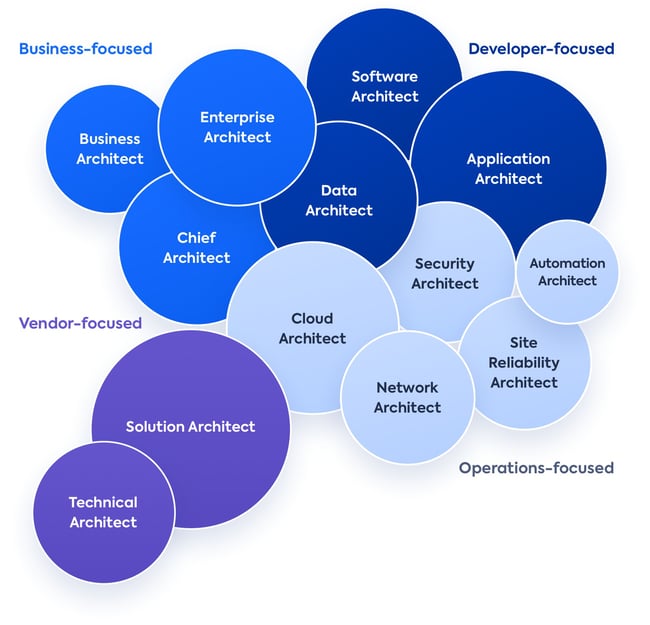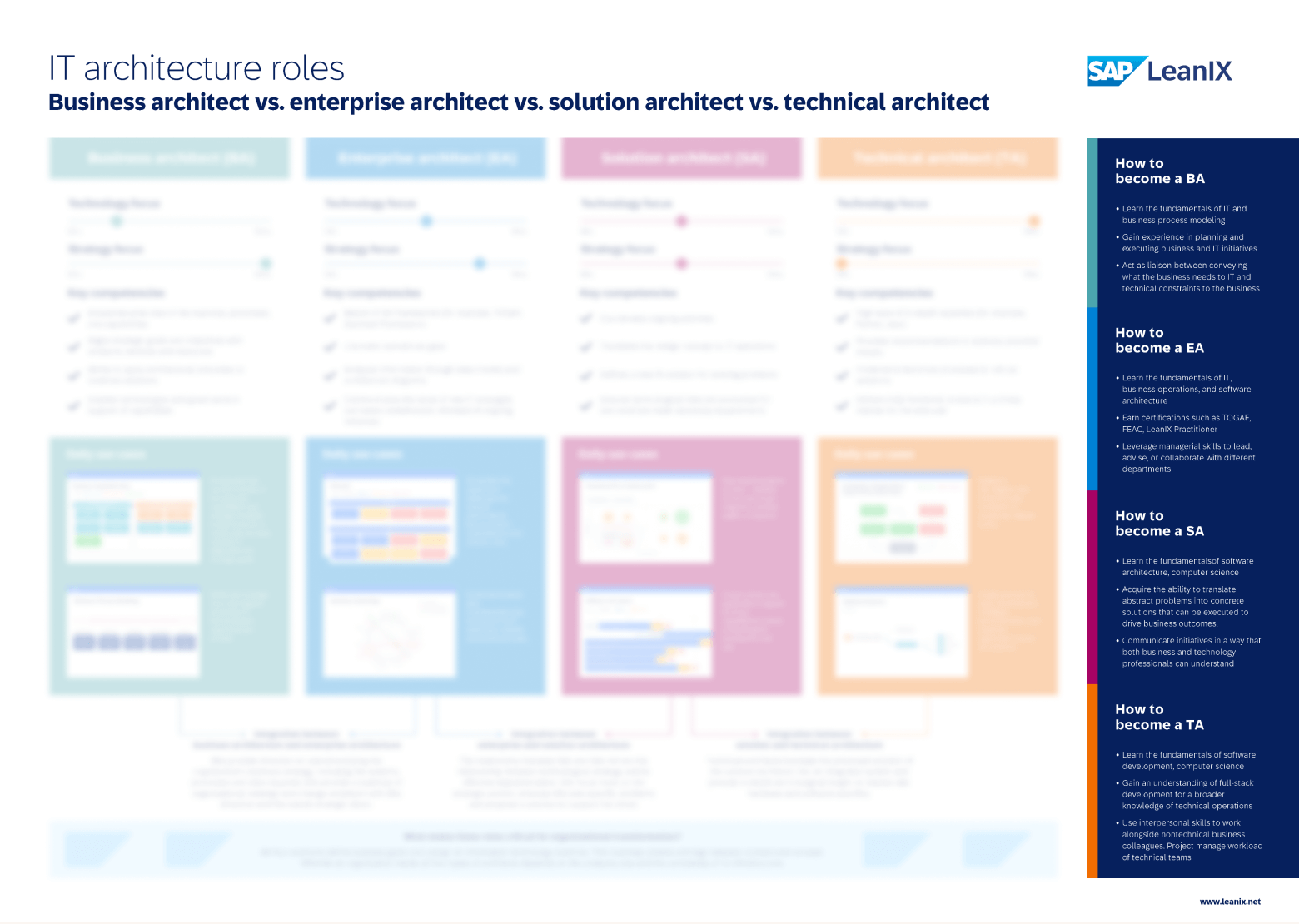Developer-focused
Developer-focused IT architects – such as software architects, application architects, and data architects work on system design from the programming and software development aspects.
These types of architects will need to have a strong understanding of programming languages, software development frameworks, and database technologies.
They will also be adept in different schools of programming, such as object-oriented and functional programming. It is their job to develop solutions using software development that benefits the organization as a whole.
1. Software architect
Role & responsibilities
Software architects drive all critical decisions in regard to an organization’s software system. They provide the design expertise, guidance, and policies relevant to developing enterprise-wide software systems. With the right technology and frameworks, they are able to satisfy the technical needs of a business.
They have a deep understanding of software architecture and its main components, as well as the interactions between these components and other external systems. They will also be familiar with cloud adoption processes and infrastructure.
Software architecture is a very senior IT position, as they provide the blueprints which the rest of the software team will put into practice.
Skills
Software architects need a deep knowledge of one or more programming languages, familiarity with diagramming complex architectures, and DevOps practices. Knowledge of cloud infrastructure is also beneficial.
Software architects also need soft skills to be successful in the role. These skills include leadership, problem-solving, organization, and the ability to prioritize. These skills are vital to make sure development and operations teams are aligned.
Career path
This is a senior-level position that requires a strong educational background in software development and information technology.
Software architects are full-stack developers and need strong experience in multiple programming languages. Most will have several years of experience as a software engineers or developers.
Further, training in DevOps, system development, and programming is also desired.
Certifications
Software architecture certificates include:
2. Application architect
Role & responsibilities
In many ways, an application architect is similar to a software architect. Application architects monitor a single application to understand its interactions with different components, other business apps, and external software. That's why they will define the limitations and requirements of the source code.
Their role includes providing expertise, guidance, and implementation policies to an enterprise within a particular programming framework. They are responsible for leading the application development team to implement application development plans.
Skills
Application architects should be well-versed in API technologies (REST, GraphQL, gRPC, etc.) and be familiar with container/binary orchestration frameworks (Kubernetes, Docker, Docker Swarm, and WebAssembly).
They also need excellent leadership and interpersonal skills to support junior developers and provide end-users with technical support. Application architects also benefit from strong analytical and problem-solving skills.
Career path
To become an application architect, candidates will need to have a bachelor’s degree in computer science, specialization in software engineering, application development, or similar.
They also need several years of work experience with programming languages and have worked as junior application developers within a related industry.
Certifications
Application architect certificates include:
3. Data architect
Role & responsibilities
Data architecture is responsible for monitoring how an organization’s IT infrastructure supports its data strategy. A data architect designs, implements and monitors how company infrastructure acquires, transports, stores, queries, and secures its data.
They are responsible for the architectural components (pipelines, cloud storage, API, data streaming, etc), and data standards. All these grant businesses a broad overview of company activities and allow them to make data-driven decisions.
Skills
Data architects need to be skilled in mathematics and data analytics and should be comfortable with data visualization, migration, and modeling.
They should also possess a strong knowledge of systems development; including the system development life cycle, project management approaches, and testing techniques. Strong knowledge of programming languages such as Python, C/C++, Java, and Perl is important.
Data architects also need strong interpersonal skills to coordinate and collaborate with users, system designers, and other developers.
Career path
To start a career as a data architect, recruiters will look for an educational background in computer science, computer engineering or a related field.
They will also look for extensive experience in data management, programming, and technology architecture. An MBA in data science, design, management and storage work is also desirable.
Many data architects begin their careers in data administration, so they can gain valuable experience in database management and warehousing.
Certifications
Certificates data architects benefit from having include:
Vendor-focused
Vendor-focused architects, such as solution architects and technical architects, apply a product or service to system designs intended to achieve business goals.
These architects need to have experience in products or services offered by external vendors, such as AWS, SAP, Google Cloud, Salesforce, etc.
They also need to know how these products will interact with the overall enterprise architecture and how they will improve systems for business needs.
Role & responsibilities
A solution architect is a specialized role, providing the groundwork for software development projects by tailoring IT solutions to specific business needs.
Solution architects require both technical and interpersonal skills to design, describe, and manage solutions. They will evaluate the existing environment and work out how different elements of business, information, and technology can be applied to solve a problem.
Skills
Successful solution architects need both hard and soft skills to achieve competency in this position. As this is a senior position, solution architects need excellent interpersonal, communication, and negotiation skills to convey complex solutions and lead their development teams.
They need experience working with software design, programming languages, and architecture. They also need to be able to implement and manage services offered by external vendors, such as SAP, Oracle, or AWS. This is where job titles most often come from, SAP architect, Oracle architect, AWS architect, etc.
Career path
Most solution architects will hold a bachelor's degree in information technology, computer science, or software information. An MBA in information systems would also be a good fit for those pursuing a role in solution architecture.
At least 5 to 10 years of hands-on experience in software development, network administration, or information technology. This will help would-be SAs develop a strong understanding of the tools and technologies needed to design and implement solutions.
Certifications
Certificates solution architects benefit from having include:
Role & responsibilities
A technical architect is another vendor-focused IT position that will design the structure of new technology systems and oversee program implementation.
Technical architects are the closest to the end-user, so they are the ones that ensure the usability and functionality of the respective technology.
They will usually have the most hands-on approach and in-depth proficiency in one single technology. Similar to SA, they are often named after their area of knowledge, e.g., SAP architect, Java, or Python architect.
Skills
A combination of hard and soft skills is vital for success as a technical architect. Technical architects are required to have advanced problem-solving skills and the ability to project manage.
This requires strong interpersonal skills, so they can communicate and collaborate with stakeholders and team members.
TA's hard skills include extensive knowledge of computer hardware and networking systems. Expertise in programming languages and familiarity with operating systems, cloud computing and cloud technologies is required.
Career path
As a technical architect, you will need to complete a bachelor’s or post-graduate degree in IT, computer science, computer engineering, or equivalent.
From here, would-be TAs tend to start their careers in system development, programming, or testing. Many also start out in software engineering which teaches them the foundation of how to build and install various applications.
As this position is a senior one, gaining experience in leadership is vital. Most technical architects will have at least five years hands-on experience in a similar or related role.
Certifications
Examples of certifications technical architects can hold include:






/EN-WP-EA-Tomorrow-Resource_Page_Thumbnail.png?width=260&height=171&name=EN-WP-EA-Tomorrow-Resource_Page_Thumbnail.png)
/EN-TopStakeholderQuestions-Poster_Resource_Page_Thumbnail.png?width=260&height=171&name=EN-TopStakeholderQuestions-Poster_Resource_Page_Thumbnail.png)


